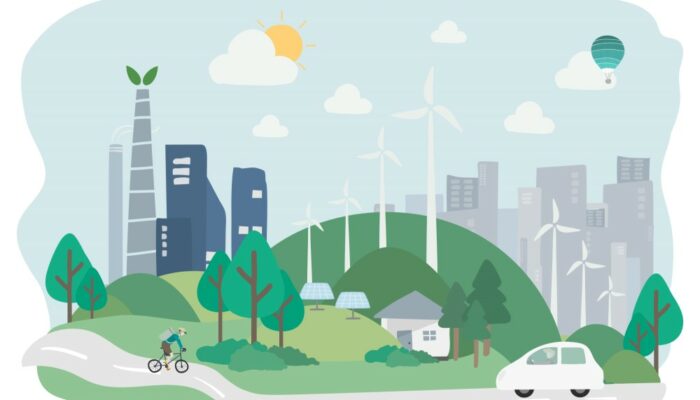
Pressure is rightly placed on the transport sector to eliminate the large volumes of carbon dioxide it emits annually, from vehicle emissions, carbon released during vehicle construction and that embedded in the supporting infrastructure.
We recognise, on the supply side, that meeting this zero-carbon challenge requires close collaboration with a wide range of industrial partners both within the transport sector, from vehicle manufacturers to transport infrastructure suppliers, and outside, particularly in relation to electricity generation and distribution companies. But this level of engagement has not been found, to date, on the demand side.
Recent national and international reports addressing climate change have stressed the need to constrain traffic growth and to encourage trip reduction and modal shift; but, beyond some workplace and school travel plans, there has been little serious engagement with the trip generating sectors of the economy, either in relation to passenger or freight transport. During the Blair government, efforts were made to get government departments to identify the carbon emissions covered by their remit, but efforts to reduce those emissions were laid at the door of individual departments: it was DfT’ s responsibility to tackle transport’s carbon emissions.
Yet we know that most travel is a derived demand and much of this is related to patterns of employment and patterns of consumption, completely outside the DfT’ s control. In terms of English domestic travel, the National Travel Survey (2019) shows that around 60% of car driver/passenger trips and 50% of car mileage is for work/education and shopping/personal business purposes; ‘leisure’ (including social activities) and escort trips account for most of the remaining travel, a substantial part of which will be to visit non-home commercial attractions.
What mechanisms can be used to reduce carbon emissions, with the support of these trip-generating sectors? The following table sets out the main possibilities, in terms of service delivery models, drawing on the EU SUMP-PLUS project[1]. There are four broad forms of delivery: (i) at fixed physical locations, (ii) using mobile physical facilities, (iii) by physical delivery of goods/services to people’s homes and (iv), through in-home provision, either physically or via the internet. Depending on the ways in which organisations provide their services, this can impact substantially on trip numbers, trip lengths and mode choices.

Increasingly there are signs that several major trip-generating sectors are recognising their role in influencing travel volumes and patterns and, encouragingly, are starting to take responsibility for the associated transport-generated carbon. This is as a result of the wide international acceptance of the Green House Gas protocol, developed by the WRI (World Resources Institute) and the WBCSD (World Business Council for Sustainable Development)[2].
Last December, for example, the NHS produced its Net Zero Carbon strategy[3], in which it recognised that 14% of all carbon emissions associated with its estate and operations comes from passenger travel: employees, patients and visitors. They are now working closely with local transport authorities in developing NHS Green Plans[4], for example, with TfGM in Greater Manchester.
The CBI also recently encouraged its members to recognise the commuting trips of their employees when accounting for carbon generated by their operations[5]. And the Welsh government is encouraging the greater home working, or working in the vicinity of home at local remote working hubs, thereby significantly reducing commuting trip lengths and making walking or cycling more practical options. Their aim is “…to have 30% of Welsh workers working at or near to home”[6].
While some commentators have talked for many years about encouraging localisation and making greater use of the internet, COVID has been instrumental in making this a reality, by demonstrating that much of daily life can be accomplished with reduced personal travel, through a combination of on-line activity and localisation of non-home activities. For example, there have been large increases in home deliveries and in on-line GP appointments.
It is only very recently that the public and private sectors have acknowledged that they need to work together to meet the challenging transport carbon reduction/ elimination targets, so there is much to learn and discuss. This issue we will be addressed in the ‘Rising to the Challenge: what will it take to decarbonise transport?’ Decarbonising Transport webinar series in September.
One caveat. Local authorities have multiple objectives they are seeking to achieve, and it is important that the chosen carbon-reduction strategies do not increase inequalities, or negatively impact other priority objectives, as was the case with the historical promotion of diesel cars.
[1] Initial conceptual framework to map and establish cross-sector Links between major trip-generating sectors of the economy, Table 4.1, Jones and Smeds (2021). SUMP-PLUS D1.4. https://sump-plus.eu/resource?t=Conceptual%20Framework%20for%20Cross-Sector%20Links.
[2] https://www.wbcsd.org/eng/contentwbc/download/2670/33469/1
[3] Delivering a ‘Net Zero’ National Health Service, December 2020. https://www.england.nhs.uk/greenernhs/wp-content/uploads/sites/51/2020/10/delivering-a-net-zero-national-health-service.pdf
[4] NHS: How to Produce a Green Plan; a three-year strategy towards net zero, June 2021. https://www.england.nhs.uk/greenernhs/wp-content/uploads/sites/51/2021/06/B0507-how-to-produce-a-green-plan-three-year-strategy-towards-net-zero-june-2021.pdf.
[5] CBI. Greener Miles: delivering a net zero vision for commuting, April 2021. https://www.cbi.org.uk/media/6558/cbi-kpmg-greener-miles-2021.pdf
About the Author
This post was written by Professor Peter Jones, OBE. Peter is Professor of Transport and Sustainable Development at the Centre for Transport Studies, UCL.
